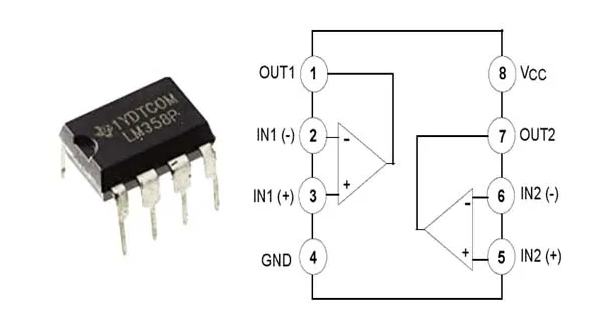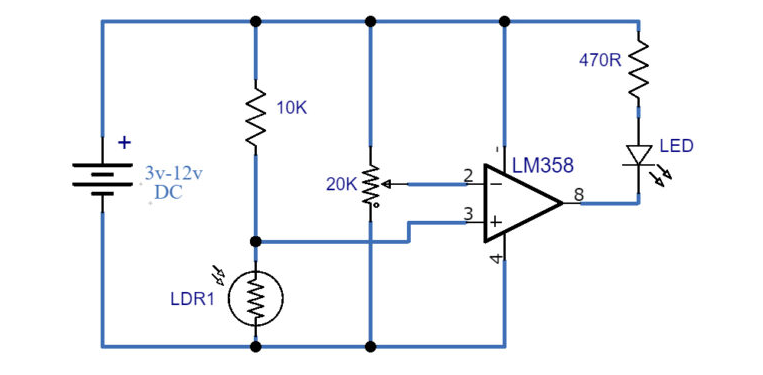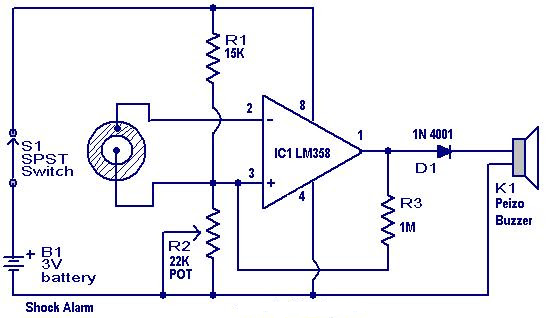Exploring LM358 IC Features, Applications, and Variants
This article delves into the comprehensive role of the LM358 IC, a dual-channel operational amplifier known for its energy efficiency and broad application range. It will uncover the detailed architecture, applications, practical implementation insights, and alternatives to the LM358 IC. It also provide a thorough understanding of its operational dynamics, pin configuration, package variations, and its integrated features that collectively contribute to its status as a transformative component in the electronic age.Catalog

Overview of the LM358 IC
The LM358 IC is a dual-channel operational amplifier known for its energy-conscious design. Developed by National Semiconductor, this component includes two high-gain, frequency-compensated op-amps, adept at independent operation from a single power source. Its broad voltage range and unique integration make it suitable for diverse applications like standard op-amp circuits and transducer amplifiers. The LM358 supports a 3-32V DC supply, and each channel can deliver up to 20mA, making it appealing in scenarios that benefit from two op-amps powered from one source within a compact 8-pin configuration.
The LM358 IC is particularly fitting for scenarios where energy efficiency is emphasized. Applications include analog signal processing and active filter design. Its compatibility with a broad voltage range enhances its usefulness in both industrial and consumer electronics. It's role in sensor interfacing involves signal amplification, bridging the gap between sensed phenomena and microcontroller inputs.
The LM358's ability to function with a single-sided power supply streamlines PCB layouts in portable devices. The LM358’s adaptability to varying power sources and robust performance across diverse conditions highlight its reliability and consistency. Its strength in amplifying weak signals with minimal noise show its design efficiency.
LM358 IC Alternatives
• LM158
• LM258
• LM2904
• LM2409
• GL 358
• NE 532
• OPA 2237
LM358 IC Pin Configuration

The LM358, a widely used operational amplifier, includes 8 distinct pins, each having its own unique role in various applications. Delving into the subtleties of these pins can greatly improve circuit design and refinement.
Comparator Outputs (Pins 1 and 7)
These pins allow for the acquisition of outputs from the operational amplifiers. They are well-suited for applications needing signal comparison, such as analog-to-digital converters. Thoughtful design of feedback loops can ensure stability and precision in signal processing, offering a nuanced approach to achieving desired outcomes.
Inverting Inputs (Pins 2 and 6)
These negative input terminals are key to defining the phase relationship of the input signal. Implementing negative feedback through these inputs enhances control over gain configurations. This technique is commonly used in amplifier circuits to achieve greater accuracy, balancing technical precision with functional needs.
Non-Inverting Inputs (Pins 3 and 5)
Functioning as positive input terminals, these pins enable signal amplification without phase inversion. Applying non-inverting configurations can improve input impedance greatly. This approach is beneficial when connecting with high-impedance sources to preserve signal integrity, reflecting strategy in maintaining communication efficacy.
Ground (Pin 4)
Serving as the circuit's reference point, the ground pin ensures stable operation. Employing grounding strategies, like using a star ground configuration, can reduce noise and enhance overall circuit performance, especially in sensitive scenarios. Such practices demonstrate the keen attention given to subtle efficiency improvements.
Positive Power Supply (Pin 8)
This pin provides the required voltage for the LM358's functionality. Maintaining a stable power supply and incorporating bypass capacitors can minimize voltage fluctuations, promoting more reliable operational amplifier performance. Careful attention to this aspect is a thoughtful consideration in environments where precision is a constant pursuit.
LM358 Package Variations
|
Package |
Dimension |
Unit |
|
DSBGA(8) |
1.31 x 1.31 |
mm |
|
PDIP(8) |
1.91 x 6.35 |
mm |
|
TO-CAN(8) |
9.08 x 9.31 |
mm |
|
SOIC(8) |
4.90 x 3.91 |
mm |
The LM358 operational amplifier comes in four distinct packaging options. Each package brings its own advantages, offering flexibility to meet diverse application needs.
DSBGA (Die Size Ball Grid Array)
This miniature, surface-mount package excels in space-limited settings like portable devices. Its compactness aids integration into contemporary electronics, prioritizing efficiency while maintaining performance.
PDIP (Plastic Dual In-line Package)
Renowned for ease of manipulation, the PDIP package is frequently utilized in prototyping and educational settings. It enables easy insertion into breadboards and socket applications. This style presents a sturdy mechanical design and sufficient robustness for early testing stages.
TO-CAN (Transistor Outline Can)
Preferred in environments demanding superior thermal performance, the TO-CAN package is chosen for its dependability and sealing abilities. It thrives in high-stress situations, making it suitable for sensitive military and industrial uses. Its metal casing offers enhanced protection against environmental challenges.
SOT-25(5) (Small Outline Transistor)
The SOT-25(5) package is another small-scale option, crafted for low-power uses. Its modest footprint and low-profile design make it apt for high-density circuit boards. Its practicality in such contexts emphasizes the goal of optimizing board space while maintaining functionality.
LM358 IC Features
Dual Frequency-Compensated Operational Amplifiers
The LM358 IC integrates dual operational amplifiers crafted for both stability and performance under demanding conditions. These op-amps are frequency-compensated, allowing steady operation even in high-gain scenarios. This capability is advantageous for applications like signal conditioning and filtering.
High Voltage Gain
Boasting a voltage gain of 100 dB, the LM358 effectively amplifies weak signals, turning minor input shifts into noticeable output variations. This trait is use in sensor applications where signals tend to be faint.
1 MHz Bandwidth
With a 1 MHz bandwidth, the LM358 adeptly handles a variety of audio and data acquisition tasks, enabling rapid and efficient signal processing. This bandwidth accommodates a broad spectrum of frequencies, making it versatile for both analog and digital systems.
Versatile Power Supply Support
The LM358's compatibility with both single and dual power supplies enhances its flexibility. This adaptability allows implementation in various power configurations, proving beneficial in battery-operated and low-voltage devices.
Minimal Supply Current
Consuming merely 500 µA of supply current, the LM358 emerges as an efficient choice for power-sensitive contexts like portable devices. This low power draw prolongs battery life and minimizes heat production, which are good in wearable tech and mobile gadgets.
Low Input Offset Voltage
Featuring a 2 mV input offset voltage, the LM358 proves beneficial in precision applications where tiny input discrepancies are detrimental. This low offset ensures accurate and stable signal processing in measurement and instrumentation circuits.
Wide Output Voltage Swing
The LM358 affords a wide output voltage swing, from just above ground to near the positive supply rail. This attribute maximizes output range and facilitates dynamic signal processing, advantageous in audio amplifiers and other signal-focused applications.
LM358 IC Applications
Dark Sensor Circuit
The dark sensor circuit harnesses the LM358 operational amplifier alongside a light-dependent resistor (LDR) to discern shifts in ambient lighting. By incorporating photodiodes or phototransistors, it opens up possibilities for various applications, such as automatic lighting systems and environmental monitoring. The circuit includes components like a 9V battery, multiple resistors, and a transistor, each adding to the circuit's overall function. A variable resistor allows users to adjust sensitivity, tailoring the circuit's response to changes in light levels.
Shock Alarm Circuit
This circuit, frequently found in automotive anti-theft systems, leverages the LM358 configured as an inverting Schmitt trigger. Paired with a piezoelectric sensor, it effectively senses mechanical vibrations or impacts. Specific resistors are used to fine-tune the detection sensitivity, facilitating precise adjustments for different settings. Such systems illustrate how sensitivity settings need careful balancing to prevent false alarms while maintaining security.
LM358 IC Advantages
Integrated Dual Operational Amplifiers
LM358 includes dual operational amplifiers that are internally compensated, eliminating the need for multiple power supplies. This simplifies the circuit design, offering efficiency in various electronic applications. The integration promotes uncomplicated design processes, optimizing component use and reducing costs, making it valuable in limited-resource settings.
Direct Ground-Level Sensing
LM358's ability to provide direct ground-level sensing without extra components is beneficial. This feature ensures accuracy and precision in sensor and instrumentation applications, aligning with modern design principles focusing on simplicity and reliability. In practical terms, it supports stable and consistent operation, especially in embedded systems and portable devices.
Suitability for Battery-Powered Applications
LM358 is well-suited for battery-operated devices due to its low power consumption and high efficiency. This feature conserves energy and extends battery life, which is advantageous in wearable technology and remote sensing applications. Its seamless integration with battery systems reduces maintenance and operational costs, presenting a practical solution for prolonged deployments.
Compatibility with Various Logic Levels
The IC's compatibility with diverse logic levels enhances adaptability across platforms. This versatility is important in mixed-signal environments, where communication between systems is needed. The ease of working with various logic standards highlights its suitability for both legacy and modern systems, facilitating smoother transitions and integrations in system upgrades.
Frequently Asked Questions [FAQ]
1. What is LM358 used for?
The LM358 operational amplifier finds its place in both transducer amplifiers and DC gain blocks. It grants a voltage gain of 100 dB, showing its adaptability in a voltage spectrum ranging from 3V to 32V for single power supplies and from ±1.5V to ±16V for dual supplies. This flexibility enthralls who delve into low-power applications. Many appreciate its broad voltage range, easing its integration into both battery-operated setups and traditional AC systems.
2. What is the difference between LM741 and LM358?
The LM358 is celebrated for its low-power consumption, catering to the needs of battery-efficient designs, unlike the LM741, which usually acts as a voltage comparator. In scenarios prioritizing power conservation, such as in portable devices, the LM358 often emerges as a commendable choice.
3. Can LM324 and LM358 be replaced?
Though LM324 and LM358 share some traits, their pin count sets them apart. The LM358 is often chosen for streamlined circuit designs prioritizing compactness and efficiency. On the other hand, the LM324 supports more intricate setups with extra pins, allowing for greater versatility. This distinction frequently influences decisions in complex systems demanding extensive integration.
4. Can LM358 and LM358S be used interchangeably in a circuit?
The LM358S variant captures attention with its heightened precision and swiftness, tailored for scenarios requiring quick response times and accuracy. These enhancements play an influential role in contemporary high-speed circuits, where rapid response is good for optimal system performance. Many observe that the LM358S offers enhanced performance under swiftly shifting conditions, supporting stability and dependability.
5. What are the advantages of LM258 compared to LM358?
The LM258 stands out as an industrial-grade option, known for delivering superior performance over the commercial-grade LM358. Its increased durability is valued in industrial settings where conditions are tumultuous. This reliability often makes the LM258 a favored choice in harsh environments, where both durability and performance are integral. In diverse applications, the LM258’s sturdiness consistently makes it a dependable ally in demanding situations.

